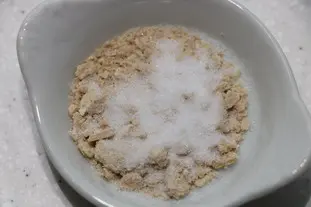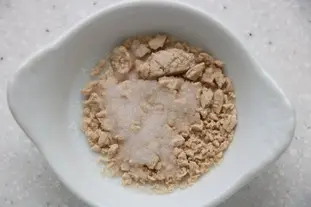This site uses only a few technical cookies necessary for its operation. By continuing to browse, you accept their use.
To find out more...
To find out more...
Salt and yeast

Let's take a look at an old baker's legend: You may have already read that somewhere in a recipe that uses baker's yeast(bread, pastries, leavened doughs in general) it is often specified "Don't put salt in contact with the yeast, you'll kill it (the yeast)"!
Well, that's a belief, and there are many in the kitchen, pastry shop or bakery, but is it true?
Well, that's a belief, and there are many in the kitchen, pastry shop or bakery, but is it true?
74 K 4.3/5 (38 reviews)
Keywords for this post:YeastSaltBakingContactLegendLast modified on: March 15th 2019
Salt and yeast
Let's look at the participants:
- On the one hand, yeast, tiny fungi "Saccharomyces cerevisiae", living beings indeed that will attack the starch of the flour (I simplify) and produce CO2, this is fermentation.
- On the other hand, the salt
Do they react if you put them in contact? Yes, a little: the salt and its hygroscopic side "pumps" the water contained in the yeast and thus softens it a little.
And then the salt will kill the mushrooms? No, not at all, even a little softened, it will keep most of its fermentation power.
In good bakery or pastry training courses, the myth is broken by mixing salt + yeast in a small bowl and letting it rest for a good hour, and you can then see that you get a kind of salty yeast, a little softened, but yeast nonetheless.
All this to tell you that no, the contact of yeast with salt is not dangerous for the yeast, don't be afraid of this, it's just a legend.
However, nothing prevents you from doing what bakers do when you pour your ingredients before kneading: they always manage to avoid putting sugar, salt and yeast in contact with each other, but this is especially in case, at the last moment, you detect a weighing error and try to correct it in a hurry!
To sum up: salt and yeast can be put together in a recipe, it won't prevent your future dough from rising.
- On the one hand, yeast, tiny fungi "Saccharomyces cerevisiae", living beings indeed that will attack the starch of the flour (I simplify) and produce CO2, this is fermentation.

- On the other hand, the salt

Do they react if you put them in contact? Yes, a little: the salt and its hygroscopic side "pumps" the water contained in the yeast and thus softens it a little.
And then the salt will kill the mushrooms? No, not at all, even a little softened, it will keep most of its fermentation power.
In good bakery or pastry training courses, the myth is broken by mixing salt + yeast in a small bowl and letting it rest for a good hour, and you can then see that you get a kind of salty yeast, a little softened, but yeast nonetheless.
 |  |  |
| Yeast alone | Yeast with salt | Yeast with salt, 1 hour later |
All this to tell you that no, the contact of yeast with salt is not dangerous for the yeast, don't be afraid of this, it's just a legend.
However, nothing prevents you from doing what bakers do when you pour your ingredients before kneading: they always manage to avoid putting sugar, salt and yeast in contact with each other, but this is especially in case, at the last moment, you detect a weighing error and try to correct it in a hurry!
To sum up: salt and yeast can be put together in a recipe, it won't prevent your future dough from rising.
Lasts posts
Getting out of the fridge early
Very often when you're cooking, you need to take food or preparations out of the fridge, to use them in the recipe in progress. There's nothing tricky about this: you just take them out of the fridge and use them, usually immediately, in the recipe. But is this really a good method?November 24th 20258315
Who's making the croissants?
When you look at a bakery from the outside, you naturally think that in the bakery, the bakers make the bread, and in the laboratory, the pastry chefs make the cakes. It's very often like that, with each of these professions having quite different ways of working, but sometimes there's also one...November 23th 2025755
Oven height
When we put a dish or cake in the oven, we naturally tend to put it on the middle shelf, and that's what we usually do. But in some cases, this position and height can be a little tricky, so let's find out why.October 8th 20252,3035
The importance of sieving
In recipes that use a fine powder (flour, powdered sugar, etc.), you'll often see the advice to sift before using it. To sift is to pass the powder in question through a sieve (a very fine strainer) before incorporating it into your recipe. It's often advice, but is it really useful?September 3rd 20257,2703
The grease spray
As soon as you have something in a recipe that sticks to the mold, the question always arises as to how difficult it is to remove from the mold. There's nothing more frustrating than breaking your cake when unmolding it, because part of it has stuck in the mold. The classic way to avoid this is...August 26th 20256,7975
Other pages you may also like
The window-pane test in bread-making
The home bread-makers often ask themselves “Have I kneaded my dough long enough?” . A good question, as dough that is insufficiently kneaded will not rise properly or will fall flat when the top is slashed, which is very frustrating. To know when the dough is ready, one can rely on the length...June 16th 202196 K 23.9
Candied fruits: don't get ripped off
Do you like candied fruit? You might like to nibble a handful or add it to a recipe, like a classic fruit cake or delicious Italian specialities like panettone or sicilian epiphany pie.June 21th 201767 K 24.2
The right weight of pastry for a pie
Let's try to solve a thorny problem: How much dough will I need when I make my next pie? You're planning to make a pie, you're going to use your favourite mould or circle, but how much pastry will you need to fill it completely with a well spread pastry, without being too thin, or on the contrary...March 20th 202066 K4.3
Foie gras service
For the upcoming christmas meals you too may be sacrificing to the tradition of foie gras? If so, I suggest you take a look at everything that revolves around serving foie gras: how to serve it, and what to eat and drink with it.December 23th 201716 K4.9
Is it really necessary to cream egg yolks?
Let’s try and answer a question that crops up in cookery and patisserie, even if it verges on the existential: do the egg yolks in a custard recipe really need to be beaten until pale, or not?February 28th 201844 K4.3
Post a comment or question
Follow this page (as 2 people already do)
If you are interested in this page, you can "follow" it, by entering your email address here. You will then receive a notification immediately each time the page is modified or a new comment is added. Please note that you will need to confirm this following.
Note: We'll never share your e-mail address with anyone else.
Alternatively: you can subscribe to the mailing list of cooling-ez.com , you will receive a e-mail for each new recipe published on the site.









